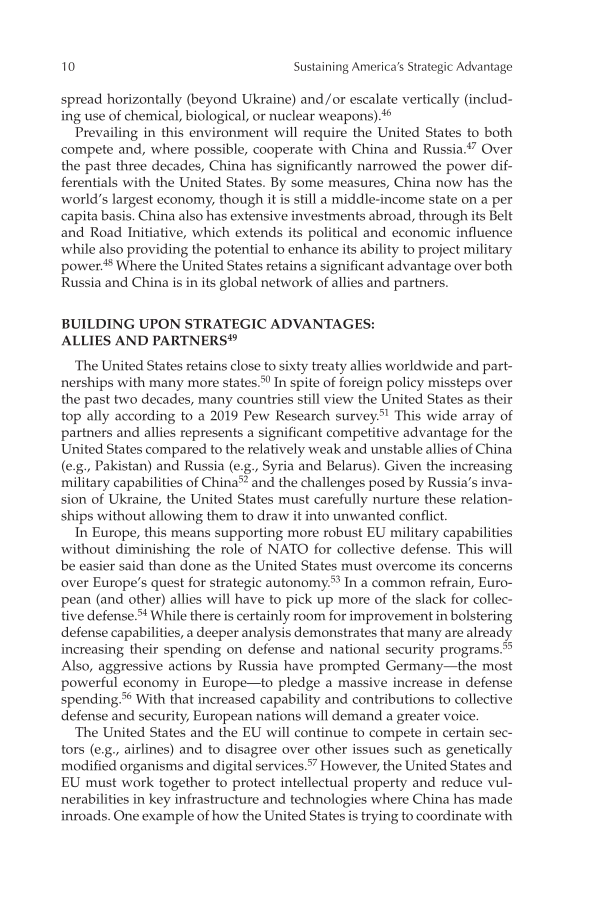10 Sustaining America’s Strategic Advantage spread horizontally (beyond Ukraine) and/or escalate vertically (includ- ing use of chemical, biological, or nuclear weapons).46 Prevailing in this environment will require the United States to both compete and, where possible, cooperate with China and Russia.47 Over the past three decades, China has significantly narrowed the power dif- ferentials with the United States. By some measures, China now has the world’s largest economy, though it is still a middle-income state on a per capita basis. China also has extensive investments abroad, through its Belt and Road Initiative, which extends its political and economic influence while also providing the potential to enhance its ability to project military power.48 Where the United States retains a significant advantage over both Russia and China is in its global network of allies and partners. BUILDING UPON STRATEGIC ADVANTAGES: ALLIES AND PARTNERS49 The United States retains close to sixty treaty allies worldwide and part- nerships with many more states.50 In spite of foreign policy missteps over the past two decades, many countries still view the United States as their top ally according to a 2019 Pew Research survey.51 This wide array of partners and allies represents a significant competitive advantage for the United States compared to the relatively weak and unstable allies of China (e.g., Pakistan) and Russia (e.g., Syria and Belarus). Given the increasing military capabilities of China52 and the challenges posed by Russia’s inva- sion of Ukraine, the United States must carefully nurture these relation- ships without allowing them to draw it into unwanted conflict. In Europe, this means supporting more robust EU military capabilities without diminishing the role of NATO for collective defense. This will be easier said than done as the United States must overcome its concerns over Europe’s quest for strategic autonomy.53 In a common refrain, Euro- pean (and other) allies will have to pick up more of the slack for collec- tive defense.54 While there is certainly room for improvement in bolstering defense capabilities, a deeper analysis demonstrates that many are already increasing their spending on defense and national security programs.55 Also, aggressive actions by Russia have prompted Germany—the most powerful economy in Europe—to pledge a massive increase in defense spending.56 With that increased capability and contributions to collective defense and security, European nations will demand a greater voice. The United States and the EU will continue to compete in certain sec- tors (e.g., airlines) and to disagree over other issues such as genetically modified organisms and digital services.57 However, the United States and EU must work together to protect intellectual property and reduce vul- nerabilities in key infrastructure and technologies where China has made inroads. One example of how the United States is trying to coordinate with
Document Details My Account Print multiple pages
Print
You have printed 0 times in the last 24 hours.
Your print count will reset on at .
You may print 0 more time(s) before then.
You may print a maximum of 0 pages at a time.











































































































































































































































































































































































